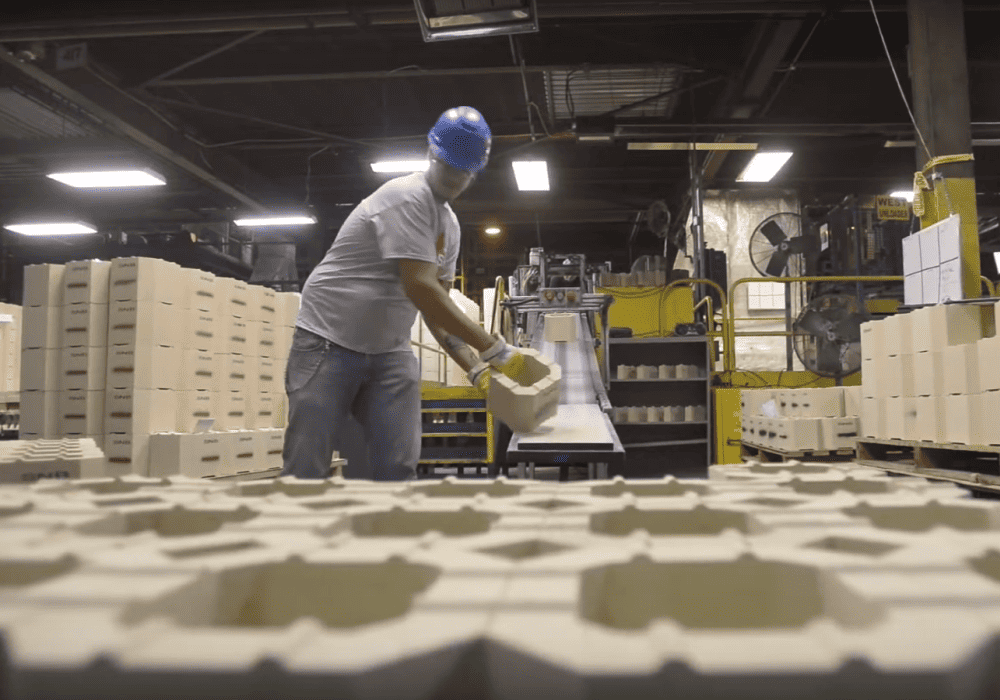
[Image above] A worker at HarbisonWalker International transfers a refractory product from the assembly line to the stack of finished goods. In the future, different materials may be used as binders in refractories to reduce the industry’s carbon emissions. Credit: HWI, A member of Calderys; YouTube
Reducing carbon emissions is a goal across all industrial sectors. In the refractories industry, one way to accomplish this feat is by replacing calcium aluminate cement (CAC) binders with alternative materials.
CAC is a rapid-hardening cement that is resistant to high temperatures and corrosive substances. These properties make CAC a great binder for monolithic refractories.
However, to create CAC, a lime-containing material is reacted with an aluminous material, producing carbon emissions. Additionally, CAC-bonded refractories must undergo a carefully controlled drying process, which involves high energy consumption and significant financial costs.
Instead of CAC binders, researchers have explored various cement-free organic and inorganic binders. Of these alternatives, geopolymers have emerged as a promising option.
Geopolymers are a class of inorganic aluminosilicate materials that consist of well-polymerized nanoparticles ranging in size from 5 to 40 nm. Advantages of using geopolymers as refractory binders include quick setting, reduced risk of explosions while drying, and optimized mechanical behavior at both low and high temperatures. Plus, geopolymers can be synthesized from industrial waste and by-products at lower temperatures.
In September 2023, CTT reported on a new geopolymer composition designed by researchers at the Federal University of São Carlos in Brazil. Their geopolymers were derived from metakaolin, a dehydroxylated form of the clay mineral kaolinite, and synthesized using several different alkaline silicate-containing liquid reagents.
The geopolymers synthesized using the sodium-based liquid reagent demonstrated the most desirable properties, with geopolymer-bonded high-alumina castables exhibiting faster setting times and enhanced flexural strength compared to CAC-bonded high-alumina castables.
These results were only preliminary, however, because commercial refractory compositions “are inherently more complex than the ones investigated in this study, as they incorporate both fine and coarse aggregates,” the researchers wrote. In this study, the experimental castables only contained fine aggregates.
The researchers concluded the paper by stating they planned to explore how well the geopolymer binder performed in the presence of fine and coarse aggregates. Now, they published a new paper in Journal of the European Ceramic Society that answers this question.
They synthesized high-alumina castables that either partially or fully replaced the traditional CAC binder with the sodium-containing geopolymer binder. Various tests were performed to determine the effect of binder choice on the processing parameters as well as thermal and mechanical performance of the resulting refractories.
The researchers drew several conclusions from the results of these tests:
- Rheological behavior. A higher weight percent of geopolymer binder in the castable required larger quantities of liquid to facilitate the mixture of components.
- Flexural strength. The geopolymer and CAC binders endow the castable with flexural strength through different mechanisms. In castables containing blends of CAC and geopolymer binders, the traditional cement hydration process was inhibited while the geopolymerization process was enhanced.
- Microstructure. During processing, the geopolymer binder forms a liquid phase that vitrifies upon cooling. This vitrification provides a strong interfacial bond between the fine and coarse components of the castables, resulting in robust castables with cohesive and rigid microstructures.
Using this knowledge, the researchers determined that optimal thermal and mechanical performance was achieved using a combination of CAC (2.7 wt.%) and geopolymer (1.3 wt.%) binders. At 1,400°C, these samples displayed shrinkage of 1.18%, elastic modulus of 135 GPa, and flexural strength of 39.1 MPa. They also demonstrated high thermal shock resistance after 10 cycles at 1,025°C (∆T ∼1,000°C).
“The obtained results demonstrate that the evaluated geopolymer binders are promising options for developing new ceramic compositions for cement-free or ultralow-cement-containing advanced refractory castables,” the researchers conclude.
The paper, published in Journal of the European Ceramic Society, is “Geopolymers: A viable binder option for ultra-low-cement and cement-free refractory castables?” (DOI: 10.1016/j.jeurceramsoc.2024.02.013).
